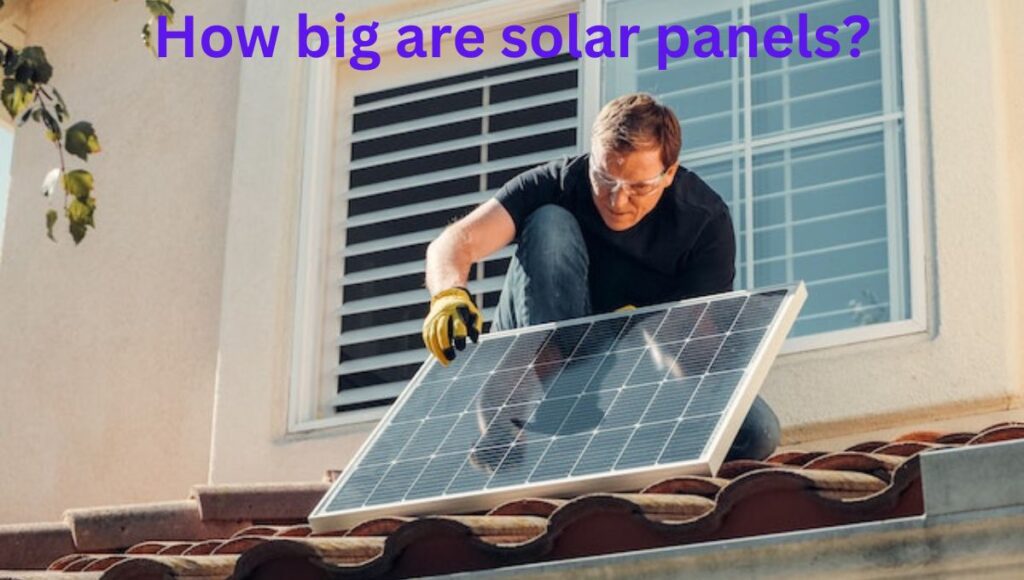Last updated on March 4th, 2025 at 11:30 pm
When you think about the future of solar and renewable energy, one question often stands out: “How big are solar panels?” These unassuming solar panels play a crucial role in capturing sunlight and transforming it into electricity, making solar power accessible to homes, businesses, and beyond.
But have you ever wondered just how much they weigh? It turns out, the size and weight of solar panels matter more than you might think. In this journey into the world of solar energy, we’ll explore the dimensions and weight of solar panels. By the time you finish reading this article, you’ll have gained a comprehensive understanding of these powerful contributors to a sustainable future.
How big are solar panels?
The size and cell configurations of solar panels play a critical role in determining their suitability for different applications, ranging from residential rooftops to vast commercial installations. There are three primary types of solar panels categorized by cell size: 60-cell, 72-cell, and 96-cell panels, each with distinct advantages and applications.
For residential applications, the nimble 60-cell panels are the perfect choice, efficiently fitting on rooftops with limited space, providing clean energy to power homes while blending seamlessly with the surroundings.
Moving to larger rooftops or medium-sized commercial spaces, 72-cell panels step in, offering a balance of size and power. Their increased wattage output ensures businesses can reduce energy costs sustainably.
On a grander scale, the mighty 96-cell panels find their niche, gracing vast commercial and utility-scale solar farms with their impressive wattage production.

Solar panel size: Dimensions of the solar panels
| Cell category | Use | Wattage range (approx) |
Dimensions ( in inches) (height × width × depth) |
Dimensions (in cms) (height × width × depth) |
Area (square feet) | Area (square meters) |
| 60-cell | Residential | 250-370 watts | 65 × 39×1.38 | 165 x 99 x 3.5 | 17.606 | 1.635 |
| 72-cell | Residential and commercial | 300-450 watts | 77 × 39×1.38 | 195.5 x 99 x 3.5 | 20.88 | 1.94 |
| 96-cell | Commercial and utility-scale solar farms | 400-600 watts | 62.6 × 41.5×1.4 | 159 x 105.4 x 3.6 | 18.06 | 1.68 |
Please note that the wattage range provided is approximate and may vary based on the specific manufacturer and technological advancements in solar panel technology. The dimensions, area, and depth mentioned are typical sizes for each category, but actual panel specifications may vary slightly depending on the model and manufacturer.
How much do solar panels weigh?
The weight of solar panels can vary not only by cell size but also by the materials used, panel type, and manufacturer. However, here are approximate weight ranges for common solar panel categories based on cell size:
1. 60-Cell Solar Panels:
- Weight Range: Typically 40 to 50 pounds (18 to 23 kilograms) per panel.
2. 72-Cell Solar Panels:
- Weight Range: Approximately 50 to 80 pounds (23 to 36 kilograms) per panel.
3. 96-Cell Solar Panels:
- Weight Range: Varies, but they can weigh over 80 pounds (36 kilograms) per panel.
What are the factors that determine the size of the solar panels?
Manufacturer Brand
Different solar panel manufacturers may have slight variations in panel dimensions and weights, depending on their specific manufacturing materials and processes. While the weight of solar panels can vary between brands, a typical 60-cell solar panel weighs around 40-50 pounds. It’s important to consider these variations when planning your installation.
Panel fabrication material
Solar panels are available in various materials, including monocrystalline, polycrystalline, and thin-film. Each material has its characteristics, which affect panel size and efficiency. Monocrystalline panels are known for their high efficiency, which allows them to produce more power per square foot, making them a compact choice. In contrast, thin-film panels are typically larger and less efficient, requiring more space for the same energy output.
Wattage and voltage
The wattage and voltage requirements of your solar system play a significant role in determining panel size. Higher-wattage solar panels often require less space because they generate more power per panel. Additionally, solar panels can be connected in series or parallel to achieve the desired voltage and current output for your specific needs.
Energy consumption
To accurately size your solar panel system, it’s crucial to match it with your desired electricity output. Start by assessing your average electricity usage, as indicated on your utility bills. Account for fluctuations due to weather changes and varying appliance usage. It’s often a good practice to overestimate your needs slightly to ensure your solar system can cover your electricity consumption effectively.

Can your roof support a solar panel system?
Before you take the leap into solar power, there are several important factors are need to be considered, such as you’ll want to know if your roof can support a solar panel system. Let’s have a conversation about it.
Roof Load-Bearing Capacity and Solar Panels
When assessing a roof’s load-bearing capacity for solar panels, several key factors come into play:
- Panel Weight: Solar panels vary in weight based on their size, type, and technology. Typically, a standard 60-cell solar panel weighs around 40 pounds (18-23 kilograms), while larger panels can weigh more. For example, a 72-cell panel may weigh around 50 to 80 pounds (23 to 36 kilograms).
- Number of Panels: The number of panels you plan to install directly affects the total weight. A typical residential solar system might consist of 20 to 40 panels or more, depending on your energy needs. This means the combined weight of all panels must be considered.
- Mounting and Racking Systems: Solar panels are mounted on racking systems, which also have a weight. The mounting hardware, rails, and brackets add to the load that the roof must support.
- Roof Load Limits: Roofs have load limits specified by building codes and engineering standards. These limits take into account factors like the type of roof structure, its age and condition, and the local climate, including snow and wind loads. For instance, a typical residential roof may be designed to support a load of 20 to 30 pounds per square foot (PSF).
To determine if your roof can support solar panels, you need to calculate the total load imposed by the panels, mounting hardware, and any additional weight (like snow in winter). This load should not exceed the roof’s specified load capacity. An engineer or experienced solar installer can perform these calculations and assess whether your roof can safely accommodate the solar panel system you have in mind.
Roof Orientation and Tilt
The way your roof is oriented and its tilt can affect the efficiency of your solar panels. Ideally, you want your panels to face the sun as directly as possible. However, solar panels can often be adjusted to work with various roof angles.
Shading and Obstructions
Consider any nearby trees, buildings, or obstructions that could cast shadows on your solar panels. Shading can reduce energy production, so it’s important to assess and minimize any potential shading issues.
Roof Material and Type
Different roofing materials and types can impact the ease of solar panel installation. Asphalt shingle roofs are common and relatively easy to work with. More complex roofing materials or configurations may require specialized mounting solutions.
Are larger solar panels better?
The Pros of Larger Solar Panels
- High Efficiency and Power Output: Larger solar panels are often more efficient at converting sunlight into electricity. This means they can generate more power per panel compared to smaller ones. If space is limited, larger panels can be an excellent choice because they allow you to maximize your energy production in a confined area.
- Fewer Panels, Reduced Complexity: When you opt for larger panels, you typically need fewer of them to achieve your desired energy output. Fewer panels mean less complexity in terms of wiring, mounting, and maintenance. This streamlined approach can simplify your solar system, reduce potential points of failure, and lower installation and maintenance costs.
- Cost Efficiency: Larger panels can also be cost-efficient. While individual larger panels may come with a higher upfront cost, you’ll save on the expense of purchasing and installing numerous smaller panels. This can lead to a lower overall cost per watt of installed capacity, potentially improving your return on investment (ROI).
- Space Optimization: Larger panels are especially advantageous if you have limited roof space. They allow you to make the most of the available area, ensuring you generate as much power as possible from your rooftop. This can be critical in urban environments or on smaller residential properties.
Considerations with Larger Solar Panels
- Aesthetic Impact: Larger panels can be more visible on your roof, potentially impacting the aesthetics of your home. Some homeowners prefer smaller panels because they are less conspicuous and can blend more seamlessly with the architectural style of the property.
- Space Requirements: While larger panels are a great space-saving option, they may not be suitable for all locations. If your roof has unusual shapes or obstructions, smaller panels might be more adaptable and easier to fit into available spaces.
- Future Growth and Flexibility: Consider your long-term energy needs. Larger panels provide a robust foundation for future expansion. If you anticipate increased energy consumption due to electric vehicles or other factors, having larger panels already in place can make it easier to add more capacity.
- Regional Factors: Your geographic location and climate are significant factors. In regions with abundant sunlight, larger panels can capture more energy and provide a quicker ROI. In areas with less sunlight, smaller panels may be sufficient and more cost-effective.
In conclusion, larger solar panels offer several advantages, including higher efficiency, reduced complexity, and potential cost savings. However, the choice between larger and smaller panels ultimately depends on your specific situation, including available roof space, aesthetic preferences, and long-term energy goals.
Final thoughts!
In the world of solar energy, understanding the size and weight of solar panels is a crucial step toward harnessing the power of the sun. Solar panels come in various dimensions, from compact residential panels to larger commercial arrays. The choice of size depends on your energy needs, available space, and budget.
Additionally, the weight of solar panels varies by size and material, which impacts installation and load-bearing considerations. Whether you’re considering a rooftop solar system or a large-scale commercial installation, grasping the nuances of solar panel size and weight ensures a well-informed journey toward a cleaner, more sustainable energy future.
Frequently Asked Questions (FAQs)

